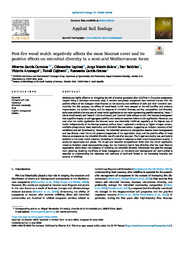Título :
Post-fire wood mulch negatively affects the moss biocrust cover and its positive effects on microbial diversity in a semi-arid Mediterranean forest |
Autor :
García-Carmona, Minerva
Lepinay, Clémentine
Mataix Solera, Jorge
Baldrian, Petr
ARCENEGUI, VICTORIA 
Cajthaml, Tomas 
Garcia-Orenes, Fuensanta  |
Editor :
Elsevier |
Departamento:
Departamentos de la UMH::Agroquímica y Medio Ambiente |
Fecha de publicación:
2023-07-11 |
URI :
https://hdl.handle.net/11000/33649 |
Resumen :
Mulches are highly effective in mitigating the risk of erosion generated after wildfires in fire-prone ecosystems. Despite being a technique commonly used, it remains completely unexplored how mulches interact with the positive effects of the emergent moss biocrust on the recovery and resilience of soils and their microbial communities. For this purpose, the effects of wood-based mulch were assayed on the soil stability and moisture improvement, the nutrient inputs, and the response of microbial biomass, activity, composition, and diversity. Soils were studied after one year of wood mulch application at two rates representing possible scenarios, “Rate 1” (65 % of soil cover), and “Rate 2” (100 % of cover), and “Control” soils without mulch. The biocrust development had a positive impact on soil aggregate stability and moisture retention before mulch application. However, one year after the mulch application the biocrust cover was drastically inhibited, especially at the highest rate of mulch. Independently of the biocrust presence, soils at Rate 1 registered a tendency to higher nitrogen content, available phosphorous, basal respiration, and microbial biomass carbon, suggesting an incipient recovery of soil conditions and soil functionality. However, the microbial community composition became more homogeneous and less diverse under the mulch presence (regardless of the application rate), and the positive effect of moss biocrust emergence on the microbial diversity was diluted after one year. The fungal community was particularly sensitive to the wood mulch presence, increasing in richness in response to fresh wood incorporation to soils, in particular saprotrophs and yeasts. The fungal and bacterial compositional shifts after the mulch application reveal an incipient wood decomposition stage, but the transitory loss in beta diversity after the moss biocrust suppression warns about the necessity of including the microbial diversity information into post-fire management planning. Studying the effects of forest management on the above and belowground soil communities is essential to understanding the resistance and resilience of semi-arid forests to the increasing intensity and severity of wildfires
|
Palabras clave/Materias:
Biological soil crust
Deadwood
Microbial community
Moss
Post-fire management
Wildfire |
Tipo de documento :
info:eu-repo/semantics/article |
Derechos de acceso:
info:eu-repo/semantics/openAccess
Attribution-NonCommercial-NoDerivatives 4.0 Internacional |
DOI :
https://doi.org/10.1016/j.apsoil.2023.105026 |
Publicado en:
Applied Soil Ecology. Volume 191, November 2023 |
Aparece en las colecciones:
Artículos Agroquímica y Medio Ambiente
|
 La licencia se describe como: Atribución-NonComercial-NoDerivada 4.0 Internacional.
La licencia se describe como: Atribución-NonComercial-NoDerivada 4.0 Internacional.
.png)
